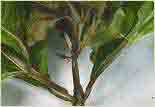Molds storage, onions: Aspergillums Niger, potatoes: Phytophthora
LinkExchange SearchMe WhatWeDo AboutUs Sitemap Next page Financial losses incurred by inadequate storage.

The worst moulds for storage are: Aspergillums Niger for onions, and Phytophthora for potatoes.
Storage and fungi
The most dangerous fungi during storage are:
- For Onions: Aspergillums Niger which causes Black Rot (Mold) of onions in storage.
- For Potatoes: Phytophthora, which causes Late Blight
Aspergillums niger

Onions with Aspergillus.

Onions with Aspergillus.
Symptoms in onions
Infected onion bulbs have a black discolouration at the neck, shallow lesions on the outer scales, streaks of black mycelium and conidia beneath the outer scales and a black discolouration in bruised areas. The entire surface of the bulb may turn black, in which case the onion will shrivel, and secondary bacteria may cause a soft rot of the bulb.
Epidemiology
This fungus is very common in the atmosphere and in the soil, and is often found as a saprophyte. Infection will usually occur through damaged tissue. The disease is usually more severe on those crops grown in a continuous rotation of susceptible hosts. Warm, moist conditions favour the growth of this fungus. Adverse weather conditions, extreme fluctuations in soil moisture, poor seed quality, seedling damage by pesticides and other factors that delay seedling emergence have been shown to increase susceptibility of plants to the pathogen. Older plants are more prone to infection, especially in dry soil. Seeds may be infected causing damping-off, and the fungus is also spread on seed. Postharvest decay is favoured by humid conditions, which encourage conidial development on the cut tissue.
Control
Fungicide seed treatments may be effective when used under conditions that promote rapid germination and emergence to prevent damping off. Postharvest black rot can be controlled if produce is stored and transported below 15°C or under very low humidity. The disease is minimised by reducing the amount of physical damage to the storage organs.
For more information:
Phytophthora causes Potato Late Blight.
Potato late blight is one of the most devastating plant diseases. The epidemics that destroyed potato crops in Europe in the 1840s led to mass starvation. For example, in the Great Irish Famine of 1845 to 1847, up to one million people died and a similar number of people emigrated to the rest of Europe and the USA. There were, of course, factors that contributed to the starvation, including the land-tenure system in Ireland at that time, and the almost total dependence of the poorer working population on potatoes as their source of food. Nevertheless, potato blight ranks as one of the most devastating diseases in human history. Even today it is one of the major pathogens that chemical companies target in their search for new fungicides.

Leaf lesion, caused by blight (phytophthora).

Damaged potato, caused by blight (phytophthora).

Leaf lesion, caused by blight (phytophthora).
The disease is caused by a fungus-like organism, Phytophthora infestans, which is a specialised pathogen of potatoes and, to a lesser extent, tomatoes (another member of the plant family Solanaceae).
Symptoms
The spores land on leaves, stems or fruit and, in the presence of free moisture, infect the plants. Infections develop into visible lesions in 4-5 days. Infected leaves develop dark green, water soaked spots that enlarge and turn brown with a light green margin. A white, fluffy growth, which produces late blight spores, can be seen around the outside of the lesions on the underside of the leaves. Late Blight spores develop in 7-10 hours at 90% relative humidity. Dark lesions and fluffy white growth also appear on the stems, often starting where the leaves attach to the stem.
Tubers are infected with Late Blight when spores are washed down through the soil by heavy rains. Infected tissue is granular, reddish brown in colour, and may extend up to 2 cm into the tuber. Fluffy, white growth may be seen on the tubers under high humidity in storage.
Preventing Late Blight
Avoid sources of inoculum: The most effective management strategy for late blight is to avoid sources of early season inoculum (spores). Late blight can only survive on living tissue, so potato tubers or tomatoes (transplants or imported fruit) are the only source of early season inoculum. One important way to avoid introducing late blight on potatoes is to plant healthy certified seed potatoes. Many states where potato seed is produced have seed certification programs to ensure that the seed meets certain standards for disease levels. Certified seed is not a guarantee that late blight will not be present, however. Examine your seed carefully before you plant, and plant only sound, blemish-free tubers. Destroy (not just putting them into cull piles) any rejected tubers that you don't plant. Other ways to avoid early season inoculum: make sure any potatoes put into compost piles are completely decomposed (rotted), and pull up and destroy any potato plants that come up from tubers that were left in the garden last season.
For more:
The most dangerous fungi during storage are:
1. for onions:
Aspergillums Niger
2. For potatoes: Phytophthora or Late Blight.
To mechanise your post harvest processes:
contact us:
Telephone:
+1 239 3002374
or use our (preferable)
our contact form
Address: Farm San Isidro, Volcán, Panama.

